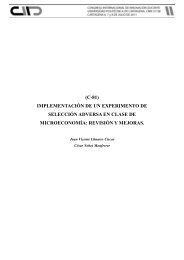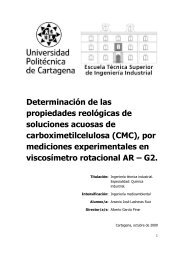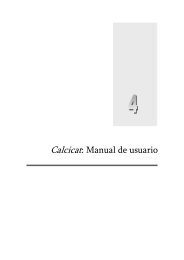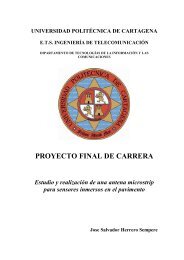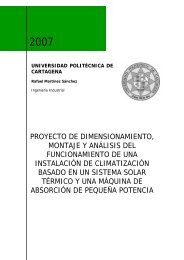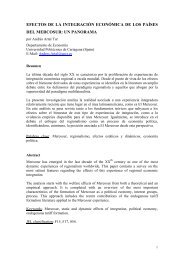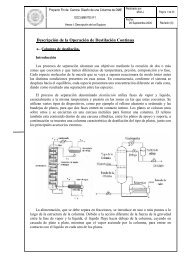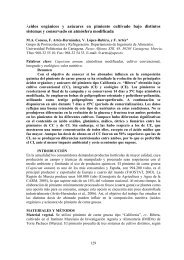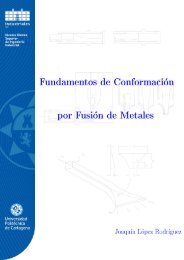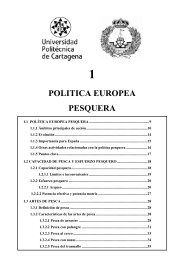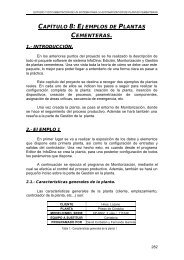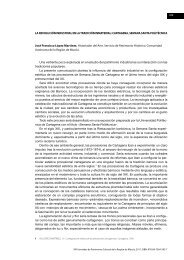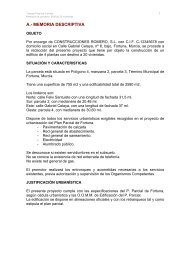Predistorted Ku-band rectangular waveguide input filter
Predistorted Ku-band rectangular waveguide input filter
Predistorted Ku-band rectangular waveguide input filter
Create successful ePaper yourself
Turn your PDF publications into a flip-book with our unique Google optimized e-Paper software.
<strong>Predistorted</strong> <strong>Ku</strong>-<strong>band</strong> <strong>rectangular</strong> <strong>waveguide</strong> <strong>input</strong> <strong>filter</strong><br />
M.T. Sancho ∗ , L. Roglá † , S. Sobrino † and A. Álvarez ∗<br />
∗ Universidad Politécnica de Cartagena<br />
Cartagena, Spain 30202<br />
Email: alejandro.alvarez@upct.es<br />
† Thales Alenia Space España<br />
Tres Cantos - Madrid, Spain 28760<br />
Email: ljroglam@thalesaleniaspace.com<br />
Abstract— In current <strong>Ku</strong>-<strong>band</strong> satellite telecommunication systems<br />
usually a working <strong>band</strong> selection is performed by means of<br />
an <strong>input</strong> <strong>filter</strong> before the LNA. Moreover, in some architectures<br />
more stringent selectivity requirements may be needed in order<br />
to reject cross-coupled transmission power signals coming into<br />
the reception chain, being necessary an spurious reject <strong>filter</strong><br />
after the LNA. On the other hand, depending on the near<br />
rejection requirements implementing transmission zeros in the<br />
<strong>filter</strong> response maybe needed. However, this also deteriorates in<strong>band</strong><br />
response, affecting channels in the extremes of the reception<br />
<strong>band</strong>. In-<strong>band</strong> response can be improved again by increasing<br />
<strong>input</strong> <strong>filter</strong> quality factor using predistortion synthesis technique,<br />
but at the cost of higher insertion loss and worse reflection<br />
response. This work analyses how predistortion technique can be<br />
applied to the design of <strong>Ku</strong>-<strong>band</strong> <strong>rectangular</strong> <strong>waveguide</strong> <strong>filter</strong>s<br />
with transmission zeros implemented through cross-couplings in<br />
order to improve in-<strong>band</strong> performances. Moreover, undesired<br />
effects arising from applying this technique are also discussed.<br />
From authors knowledge, it is the first time this synthesis<br />
technique is applied to <strong>rectangular</strong> <strong>waveguide</strong> <strong>filter</strong>s with crosscouplings.<br />
Index Terms— predistortion, <strong>waveguide</strong> <strong>filter</strong>, ku-<strong>band</strong>.<br />
I. INTRODUCTION<br />
In satellite communications systems high performance <strong>filter</strong>s<br />
are needed in order to reject unwanted signals introducing<br />
deleterious effects into the communication chain [1]. Due to<br />
the special characteristics of satellite communication systems,<br />
where extremely weak signals coming from earth are received<br />
while high power signals are transmitted back, highly selective<br />
<strong>filter</strong>s are needed. Input <strong>filter</strong>s are used in satellites to select<br />
reception <strong>band</strong> while rejecting transmission <strong>band</strong> signal leaked<br />
into the reception chain. Particularly, <strong>input</strong> <strong>filter</strong>s used in<br />
satellites usually have to provide low loss, high selectivity<br />
and a wide spurious free <strong>band</strong>. Moreover, since the reception<br />
<strong>band</strong> carries several channels, <strong>input</strong> <strong>filter</strong> pass<strong>band</strong> flatness is<br />
also important in order to minimize deterioration of channels<br />
laying at the extremes of the reception <strong>band</strong>. On the other<br />
hand, every equipment used in satellite systems, including<br />
<strong>filter</strong>, is required to have low mass and size, since launch<br />
cost is proportional to the overall mass of the satellite. When<br />
using classical <strong>filter</strong> synthesis techniques size/mass and highly<br />
selective/flat response are opposite goals. So, it is needed<br />
to look for a trade-off between electrical performance and<br />
physical dimensions.<br />
The quality factor (Q) parameter measures the quantity of<br />
energy released at the output of the <strong>filter</strong> with respect to<br />
the energy at the <strong>input</strong> [2]. When using classical synthesis<br />
techniques there is a direct relationship between quality factor<br />
and response pass<strong>band</strong> flatness. In fact, the lower the quality<br />
factor the bigger the round off of the response pass<strong>band</strong>.<br />
This round off limits the usable <strong>band</strong>width of the <strong>filter</strong>. The<br />
achievable Q factor is imposed by the technology used to<br />
implement resonant cavities composing the <strong>filter</strong>. Typically,<br />
<strong>input</strong> <strong>filter</strong>s required for <strong>Ku</strong>-<strong>band</strong> have been implemented<br />
using <strong>rectangular</strong> in-line topologies with <strong>waveguide</strong> cavities<br />
and classical synthesis techniques [3], [4]. However, as spectrum<br />
becomes scarcer applications require more selective and<br />
demanding <strong>filter</strong>s. For such applications more complex <strong>filter</strong>s<br />
implementing transmission zeros or with higher Qs than those<br />
achievable with <strong>rectangular</strong> <strong>waveguide</strong> are needed. Current<br />
solutions for <strong>rectangular</strong> <strong>waveguide</strong> in <strong>Ku</strong>-<strong>band</strong> implement<br />
transmission zeros by means of cross-couplings in folded<br />
topology or using extracted pole topologies. This increases<br />
complexity but manufacturing techniques are simple. If a<br />
higher Q is needed, cylindrical <strong>waveguide</strong> becomes an option<br />
[5]. Cylindrical cavity dual-mode <strong>filter</strong>s have superior performances<br />
with respect to its <strong>rectangular</strong> cavity counterparts,<br />
but at the expense of increasing manufacturing complexity.<br />
For <strong>input</strong> <strong>filter</strong> application it would be desirable to increase<br />
<strong>rectangular</strong> cavity <strong>filter</strong>s Q in order to achieve cylindrical<br />
cavity <strong>filter</strong>s performances with an easier to manufacture<br />
technology. For a certain mode, cavity dimensions are chosen<br />
in order to maximize Q while maintaining a wide spurious free<br />
range [2] (another mandatory requirement for <strong>input</strong> <strong>filter</strong>s).<br />
Due to higher order modes, mode selection is quite limited<br />
to modes with Q around 5000 in <strong>Ku</strong>-<strong>band</strong>, in contrast with<br />
10000 in cylindrical cavities.<br />
Recently, novel synthesis methods exploiting predistortion<br />
techniques have been proposed [6], [7], and applied to the design<br />
of more compact <strong>filter</strong>s [8]. Another approach (followed<br />
in this work) is to use this techniques to design <strong>filter</strong>s showing<br />
flatter pass<strong>band</strong>s. This is somehow equivalent to design a <strong>filter</strong><br />
with classical techniques considering a higher Q. For this reason,<br />
the concept of effective quality factor Q eff is introduced
for predistorted <strong>filter</strong>s to indicate the Q that a classical <strong>filter</strong><br />
must provide in order to show the same pass<strong>band</strong> flatness.<br />
However, due to physical limitations, this improvement in the<br />
Q produces an increase of the <strong>filter</strong> insertion losses and a<br />
degradation of return losses. As will be shown later both<br />
problems could be addressed fairly straightforward in <strong>Ku</strong>-<strong>band</strong><br />
communication payloads.<br />
A. Circuital Design<br />
II. FILTER DESIGN<br />
Classic <strong>filter</strong> synthesis techniques assume that <strong>filter</strong>s are<br />
composed of non-dissipative elements (lossless prototype <strong>filter</strong>).<br />
However, in practice <strong>filter</strong>s are made of distributed<br />
elements that show some losses. These losses are described by<br />
the unloaded quality factor Q u , which in the lossless synthesis<br />
is assumed to be infinite. If a finite Q u is considered in the<br />
synthesis, then it is equivalent to add a positive real factor δ<br />
to the purely imaginary frequency variable s = jω.<br />
δ =<br />
f c 1<br />
(1)<br />
BW Q u<br />
This shifts singularities of the <strong>filter</strong>ing function (poles and<br />
zeros) away from the imaginary axis, so that in-<strong>band</strong> insertion<br />
losses arise and reflection and transmission responses are<br />
distorted appearing a round-off in the transmission response.<br />
Classical predistortion synthesis technique allows highperformance<br />
<strong>filter</strong>ing responses using low Q resonators. This<br />
is achieved by modifying the effect of losses over the response<br />
in the synthesis process, by performing the opposite mathematical<br />
operation over (1). In consequence, when the predistorted<br />
<strong>filter</strong> works in the presence of loss a compensation occurs.<br />
However, restoring <strong>filter</strong> Q causes an increase in insertion loss<br />
and a degradation of return loss.<br />
Adaptive predistortion is an evolution of classical predistortion<br />
in which corrections are weighted by an arbitrary vector<br />
v i obtained by optimizing the <strong>filter</strong> response. This approach<br />
tries to restore <strong>filter</strong> Q to an effective or desirable quality factor<br />
(Q eff ) bigger than the Q u . This approach results in much less<br />
insertion and return loss penalty without degrading seriously<br />
in-<strong>band</strong> response linearity.<br />
In order to synthesize a predistorted response it is<br />
needed: the <strong>filter</strong>ing functions and singularities from the nonpredistorted<br />
lossless lowpass prototype <strong>filter</strong>, the <strong>band</strong>pass<br />
parameters (f c and BW ), the anticipated Q u , the desired<br />
quality factor (Q eff ) and the weight vector (v). In this work<br />
we have predistorted a six poles <strong>filter</strong> with two transmission<br />
zeros located at ω = ±2.2, centered at f c = 13.05 GHz with<br />
BW = 340 MHz <strong>band</strong>width, and RL = 21 dB. The desired<br />
target quality factor has been set to Q eff > 15000.<br />
In order to obtain the anticipated Q u the <strong>rectangular</strong> <strong>waveguide</strong>s<br />
mode chart is used to choose initial cavity dimensions.<br />
Assuming a = 2b and considering silver as material and<br />
working mode the fundamental one (T E 101 ), we choose<br />
(a/l) 2 = 0.5 obtaining an anticipated Q u of 5177, then<br />
Q eff /Q u ≃ 3. The weight vector is chosen to be v =<br />
[1.5 1.5 1.1 1.1 0.9 0.9]. We calculate the shift factor<br />
σ using the formula:<br />
f c<br />
σ i = v i<br />
BW<br />
( 1<br />
Q u<br />
− 1<br />
Q eff<br />
)<br />
with i = 1, . . . , N (2)<br />
This shift factor is applied to the poles of the <strong>filter</strong>ing<br />
function e k to obtain the predistorted <strong>filter</strong> poles e kr = e k +σ.<br />
Shifted poles must comply Hurtwiz’s condition so from (2) the<br />
maximum achievable Q eff can be computed.<br />
From predistorted poles polynomials E(s) and P (s) that<br />
define the predistorsted transfer function S 21 (s) can be calculated,<br />
since transmission zeros p k remain unchanged. Then,<br />
numerator polynomials of the reflection functions S 11 (s)<br />
and S 22 (s) (F (s) and F 22 (s) respectively) can be obtained<br />
applying the conservation of energy condition and taking<br />
paraconjugated pairs of zeros around the imaginary axis. Zeros<br />
for the polynomial F (s) are selected one by one arbitrarily,<br />
taking one of each pair. The paraconjugated polynomial<br />
F 22 (s) is composed of the remaining zeros, generating the<br />
complementary function. There are 2N possible combinations<br />
of zeros to set up the polynomials. We chose the distribution<br />
of reflection zeros maximizing or minimizing µ parameter<br />
calculated as:<br />
N∑<br />
µ =<br />
Re(f<br />
∣<br />
kr )<br />
(3)<br />
∣<br />
k=1<br />
,where f kr are the coefficients of the corresponding F (s)<br />
polynomial.<br />
The distribution of the reflection zeros sets the symmetry<br />
and synchrony of the folded coupling matrix. Supposing that<br />
the non-predistorted matrix is synchronous (without frequency<br />
offsets) and symmetric (symmetrical realization), if µ is maximized<br />
the folded coupling matrix remains synchronous but<br />
becomes asymmetrical. On the other hand, if µ is minimized<br />
the predistorted folded coupling matrix obtained is maximally<br />
symmetric but asynchronous. The later case produces a <strong>filter</strong><br />
more difficult to tune. Table I shows zeros and poles obtained<br />
for the predistorted <strong>filter</strong> computed from the non-predistorted<br />
ones. From them it is possible to obtain the predistorted<br />
folded canonical N+2 coupling matrix (see Table II), whose<br />
response is shown in Fig. 1. If the effect of loss is included<br />
in the lossless prototypes synthesized, an insertion loss of<br />
0.259 dB for the non-predistorted <strong>filter</strong> and 0.3747 dB for<br />
the predistorted one is obtained.<br />
B. Electromagnetic Design<br />
For obtaining the required coupling values of the predistorted<br />
coupling matrix in II, four different coupling mechanisms<br />
(see Fig. 2a-d) have been characterized using a full-wave<br />
EM simulator. Using these characterizations initial dimensions<br />
of the overall structure (see Fig. 2e) have been obtained. Final<br />
dimensions are obtained from full-wave EM analysis of the<br />
complete model and computer aided tuning. This later step<br />
takes into account additional interactions (parasitic effects) not<br />
considered in coupling mechanisms characterization.
Reflection zeros<br />
non-predistorted<br />
<strong>filter</strong> (f k )<br />
Reflection zeros<br />
predistorted<br />
<strong>filter</strong> (f kr )<br />
RX/TX poles<br />
non-predistorted<br />
<strong>filter</strong> (e k )<br />
RX/TX poles<br />
predistorted<br />
<strong>filter</strong> (e kr )<br />
+0.9684j -0.2210 - 0.2796j -0.1261 + 1.0923j -0.1216 + 1.0923j<br />
-0.9684j 0.1414 - 0.7489j -0.1261 - 1.0923j -0.1216 - 1.0923j<br />
+0.7206j -0.1414 + 0.7489j -0.3717 + 0.8287j -0.3662 + 0.8287j<br />
-0.7206j 0.2210 + 0.2796j -0.3717 - 0.8287j -0.3662 - 0.8287j<br />
+0.2680j -0.9856j -0.5433 + 0.3134j -0.5359 + 0.3134j<br />
-0.2680j +0.9856j -0.5433 - 0.3134j -0.5359 - 0.3134j<br />
TABLE I<br />
ZEROS AND POLES OF THE NON-PREDISTORTED AND PREDISTORTED FILTERS.<br />
S 1 2 3 4 5 6 L<br />
S 0 1.0128 0 0 0 0 0 0<br />
1 1.0128 0.0438 0.8490 0 0 0 0 0<br />
2 0 0.8490 0.0514 0.6037 0 -0.0525 0 0<br />
3 0 0 0.6037 -0.0777 0.6381 0 0 0<br />
4 0 0 0 0.6381 0.0774 0.6038 0 0<br />
5 0 0 -0.0525 0 0.6038 -0.0518 0.8482 0<br />
6 0 0 0 0 0 0.8482 -0.0431 1.0118<br />
L 0 0 0 0 0 0 1.0118 0<br />
R S = 1.0258 R L =1.0237<br />
TABLE II<br />
FOLDED CANONICAL N+2 PREDISTORTED LOW PASS COUPLING MATRIX.<br />
clearly shows that predistorted response insertion and return<br />
losses are worse in the predistorted <strong>filter</strong>, but it presents also<br />
better insertion loss flatness in the pass<strong>band</strong>.<br />
Table III summarizes the obtained results. In both cases, the<br />
Q u obtained by simulation is lower than the theoretical, and<br />
correspondingly insertion losses are also higher. Moreover, the<br />
simulated Q eff is lower than the theoretical one. This is due<br />
to the fact that we used an adaptive predistortion method.<br />
Non-predistorted <strong>Predistorted</strong><br />
Theo. Sim. Theo. Sim.<br />
IL 0.259 ≃0.3 0.3747 ≃0.4<br />
Q u 5177 4595.1 5177 4677.4<br />
Q eff - - 15531 11652<br />
Fig. 1.<br />
Theoretical predistorted response.<br />
TABLE III<br />
SUMMARY TABLE OF RESULTS OBTAINED.<br />
Fig. 3 shows theoretical response of the non-predistorted<br />
<strong>filter</strong> and the response of the structure in Fig. 2e after tuning it<br />
to obtain a non-predistorted response. Fig. 4 shows theoretical<br />
response of the predistorted <strong>filter</strong> and the response of the<br />
structure in Fig. 2e after tuning it to obtain a predistorted response.<br />
Differences between theoretical and simulated (tuned)<br />
responses are due to parasitic couplings and frequency offsets<br />
not considered in the synthesis (as it is difficult to know them<br />
“a priori”).<br />
III.<br />
RESULTS ANALYSIS<br />
Finally, losses are included in the EM model setting aluminium<br />
conductivity (σ = 38·10 6 S/m) in all the walls. Fig. 5<br />
<strong>Ku</strong>-<strong>band</strong> predistorted <strong>filter</strong> shows only 0.1 dB of additional<br />
loss with respect to its non-predistorted counterpart.<br />
Moreover, adaptive predistortion used here causes just a small<br />
degradation of return loss. Depending on the application this<br />
performance degradation could be acceptable for <strong>input</strong> <strong>filter</strong>s,<br />
where noise figure will be also affected by the same amount<br />
of losses. Additionally, for spurious rejection <strong>filter</strong>s, a more<br />
aggressive predistortion could be applied since return loss<br />
performance loss could be recovered by means of isolators,<br />
and previous LNA amplification would mitigate insertion loss<br />
and noise figure increase.
Fig. 4. Theoretical predistorted response without considering parasitic<br />
couplings (theo) and considering them (real).<br />
Fig. 2. Full-wave EM models a) external coupling, b) in-line inductive<br />
coupling, c) folded inductive coupling, d) capacitive cross-coupling, and e)<br />
overall structure.<br />
Fig. 5. Comparison between non-predistorted and predistorted responses S 11<br />
(top) and S 21 (bottom).<br />
Fig. 3. Theoretical non-predistorted response without considering parasitic<br />
couplings (theo) and considering them (real).<br />
IV. CONCLUSION<br />
In this work an adaptive predistortion synthesis has been<br />
applied to the design of a six-pole predistorted <strong>rectangular</strong><br />
cavities <strong>filter</strong> with two transmission zeros and folded topology.<br />
Responses obtained from full-wave EM simulations of the<br />
complete structure show very good agreement with expected<br />
theoretical responses. It seems feasible to use this method in<br />
order to design high performance (Q > 10000) <strong>input</strong> <strong>filter</strong>s<br />
with transmission zeros in standard <strong>rectangular</strong> <strong>waveguide</strong><br />
technology.<br />
REFERENCES<br />
[1] G. Maral, M. Bousquet, and Z. Sun, Satellite communications systems:<br />
systems, techniques and technology. Wiley, 2009.<br />
[2] G. Matthaei, L. Young, and E. Jones, Microwave <strong>filter</strong>s, impedancematching<br />
networks, and coupling structures. Artech House Dedham,<br />
MA, 1980, vol. 1964.<br />
[3] R. Cameron, “General coupling matrix synthesis methods for chebyshev<br />
<strong>filter</strong>ing functions,” IEEE Trans. Microwave Theory Tech., vol. 47, no. 4,<br />
p. 433–442, 1999.<br />
[4] A. Atia and A. Williams, “Narrow-<strong>band</strong>pass <strong>waveguide</strong> <strong>filter</strong>s,” IEEE<br />
Trans. Microwave Theory Tech., vol. 20, no. 4, p. 258–265, 1972.<br />
[5] L. Accatino, G. Bertin, and M. Mongiardo, “A four-pole dual mode<br />
elliptic <strong>filter</strong> realized in circular cavity without screws,” IEEE Trans.<br />
Microwave Theory Tech., vol. 44, no. 12, p. 2680–2687, 1996.<br />
[6] A. Williams, W. Bush, and R. Bonetti, “Predistortion techniques for<br />
multicoupled resonator <strong>filter</strong>s,” IEEE Trans. Microwave Theory Tech.,<br />
vol. 33, no. 5, p. 402–407, 1985.<br />
[7] M. Yu, W. Tang, A. Malarky, V. Dokas, R. Cameron, and Y. Wang,<br />
“Predistortion technique for cross-coupled <strong>filter</strong>s and its application to<br />
satellite communication systems,” IEEE Trans. Microwave Theory Tech.,<br />
vol. 51, no. 12, p. 2505–2515, 2003.<br />
[8] M. Yu and V. Miraftab, “Shrinking microwave <strong>filter</strong>s,” Microwave Magazine,<br />
IEEE, vol. 9, no. 5, p. 40–54, 2008.



